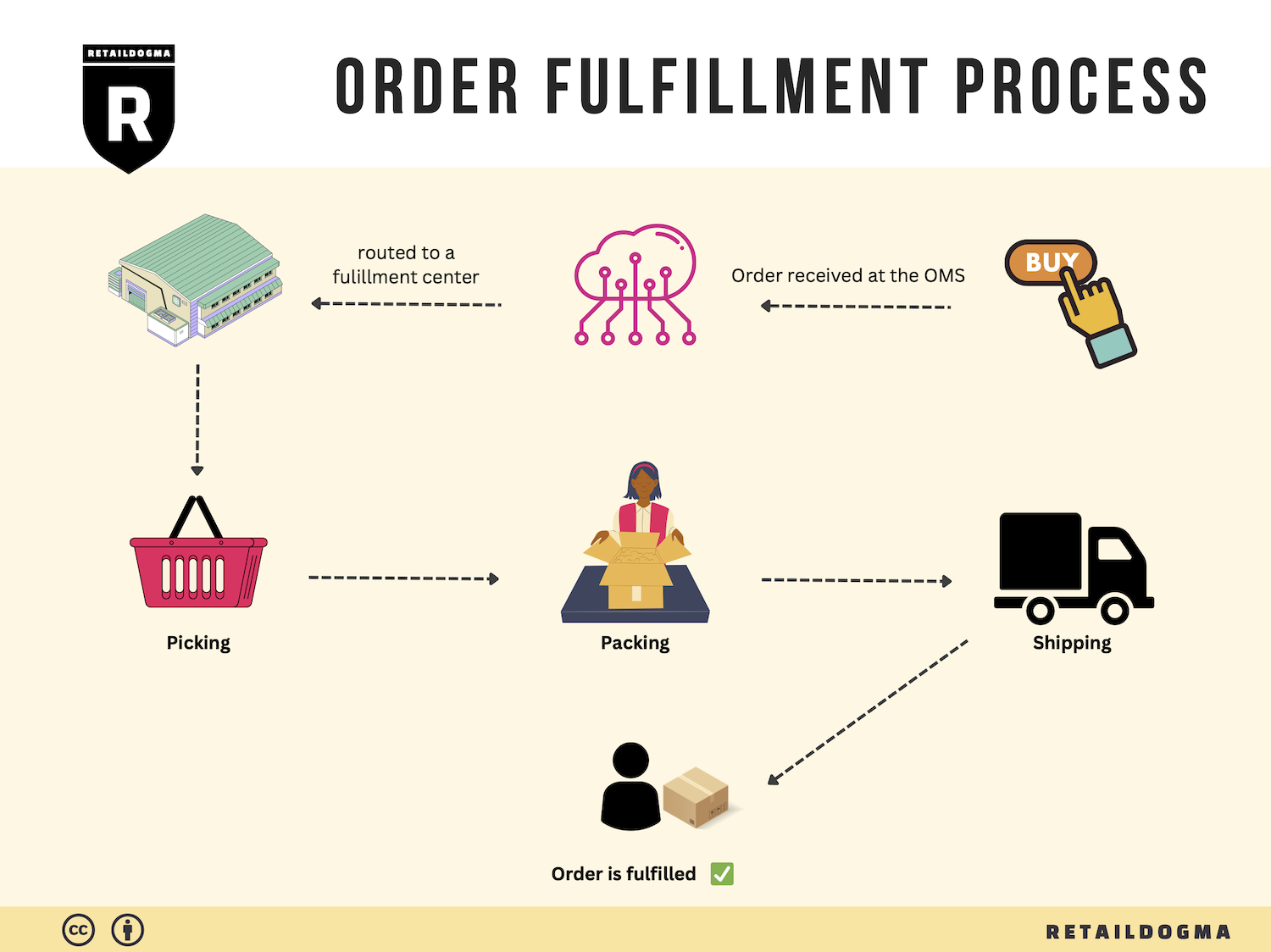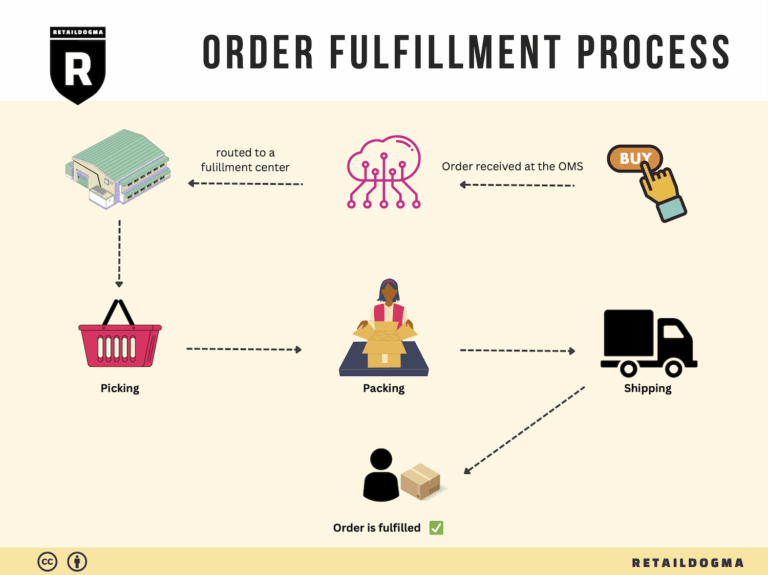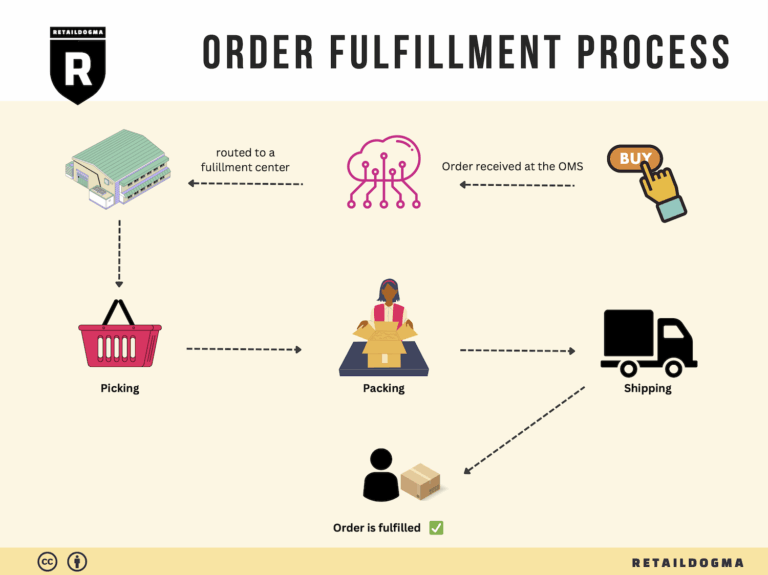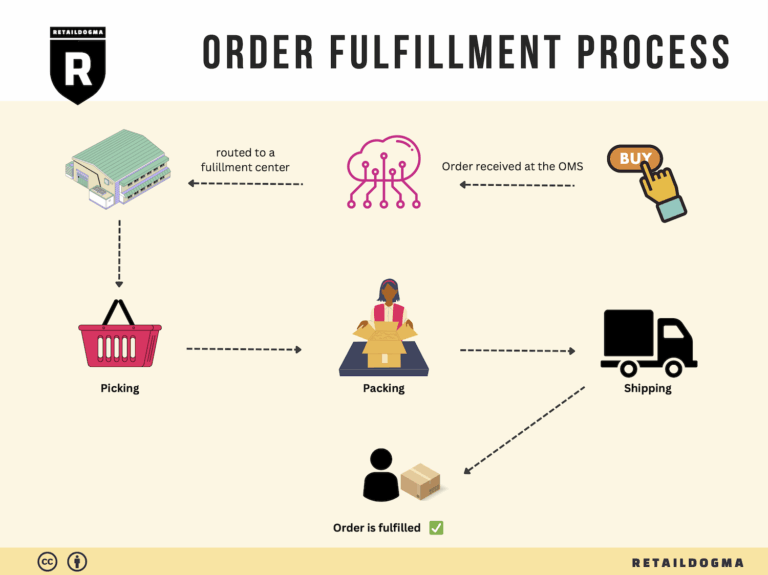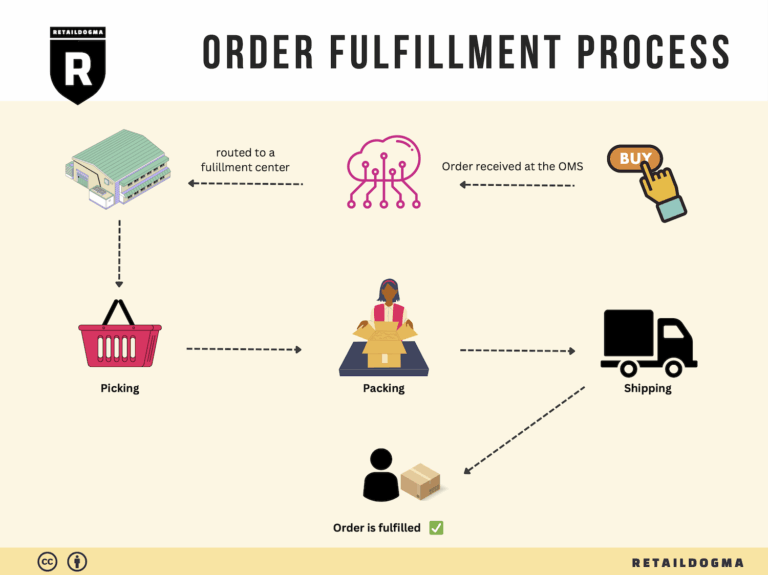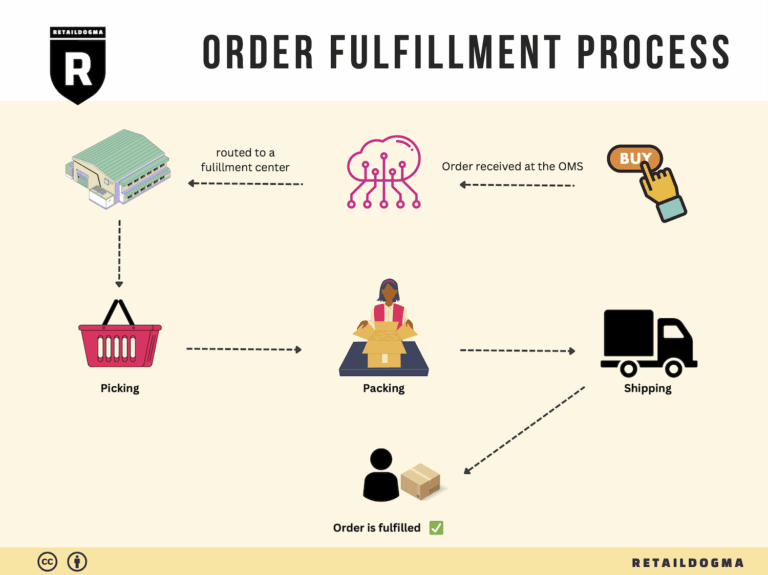What Is A Fulfillment Center? A Complete Guide (2025)
What is E-commerce Fulfillment? An Introduction for Growing Businesses
Understanding E-commerce Fulfillment
For many growing e-commerce businesses, the excitement of scaling sales can quickly turn into a daunting challenge when it comes to packing and shipping orders. As sales increase, so does the volume of orders that need to be processed, packed, and delivered. This often leads to overwhelmed teams, delayed shipments, and dissatisfied customers—issues that can stifle growth and tarnish a brand’s reputation.
So, what exactly is fulfillment? At its core, e-commerce fulfillment is the process of getting a product from the seller to the customer. This encompasses a series of steps, including inventory management, order processing, packing, shipping, and handling returns. For businesses looking to thrive in the competitive online marketplace, mastering fulfillment is not just a necessity; it’s a strategic advantage.
This guide aims to demystify the landscape of e-commerce fulfillment, providing actionable insights tailored for businesses eager to streamline their logistics. We will explore various fulfillment models, including Third-Party Logistics (3PL) and Fulfillment by Amazon (FBA), helping you understand the benefits and drawbacks of each. You’ll learn about the core services involved in fulfillment, such as storage, order picking, packing, shipping, and returns management.
Choosing the right fulfillment partner is crucial for your business’s success. This guide will discuss the key factors to consider when selecting a partner, including their technology capabilities, shipping speed, customer service, and scalability. Additionally, we will break down the pricing structures commonly associated with fulfillment services, ensuring you can budget effectively while maximizing your ROI.
Ultimately, the goal of this guide is to empower you to make informed decisions about your logistics strategy. By understanding the complexities of e-commerce fulfillment and the available options, you can optimize your operations, improve customer satisfaction, and position your business for sustained growth. Whether you are just starting or looking to refine your existing processes, this guide will serve as a valuable resource on your journey toward fulfillment excellence.
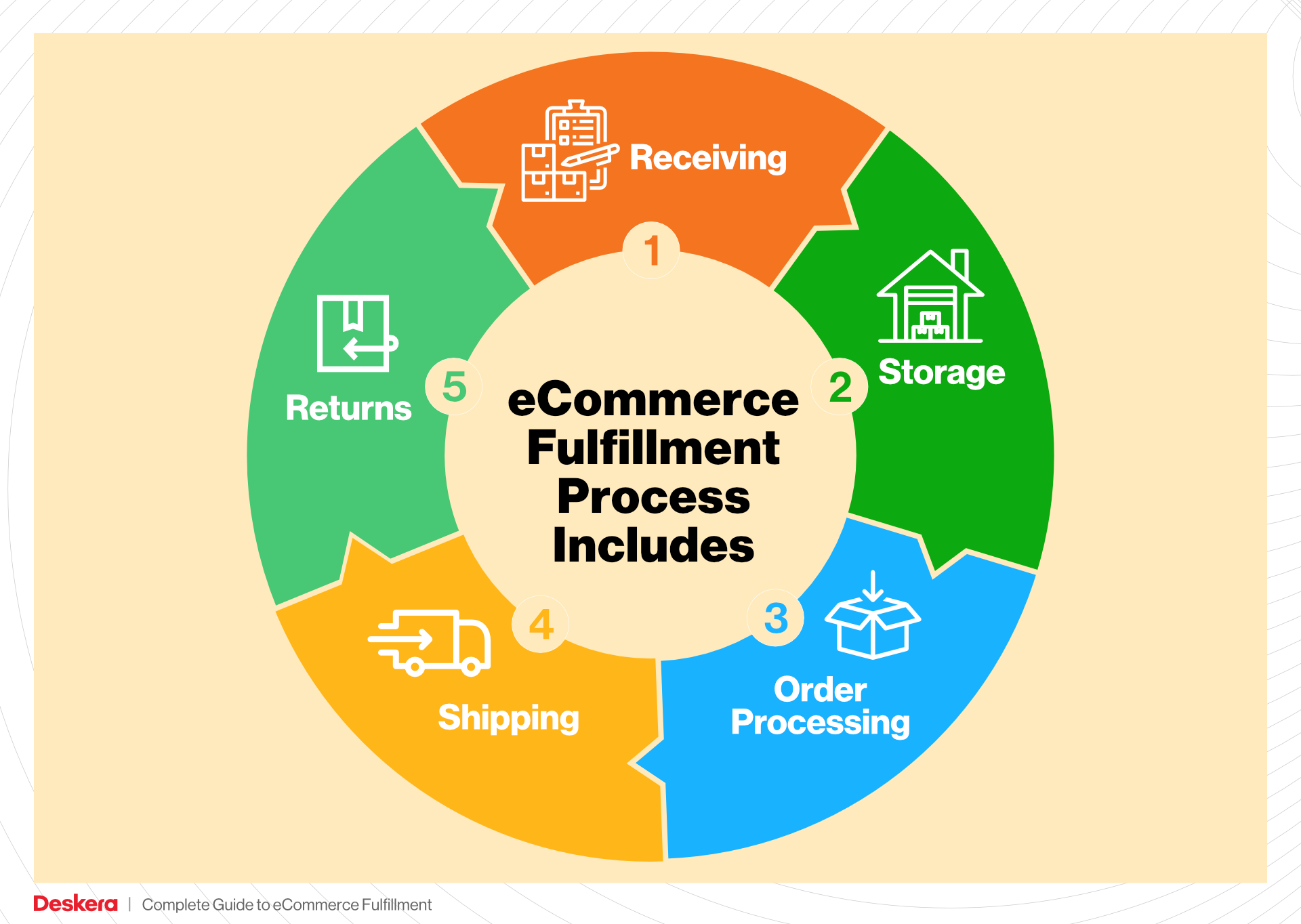
What You’ll Learn In This Guide
- What is E-commerce Fulfillment? An Introduction for Growing Businesses
- The Order Fulfillment Process: From ‘Buy’ Button to Customer’s Door
- Comparing Fulfillment Models: In-House vs. 3PL vs. Dropshipping
- A Deep Dive into Amazon FBA: Pros, Cons, and Who It’s For
- Core Services Offered by Fulfillment Centers
- How to Choose a Fulfillment Partner: A 6-Point Checklist
- Understanding Fulfillment Pricing: A Breakdown of Common Fees
- Frequently Asked Questions (FAQs) about Fulfillment
- Conclusion: Is Outsourcing Fulfillment the Right Move for Your Business?
- Important Disclaimer
The Order Fulfillment Process: From ‘Buy’ Button to Customer’s Door
1. Receiving Inventory
The first step in the order fulfillment process is receiving inventory. This involves the careful handling and processing of products as they arrive at the fulfillment center. Upon arrival, each product is checked against the purchase orders to ensure accuracy in quantity and condition. This step is critical, as it establishes the foundation for effective inventory management.
Importance: Accurate receiving prevents stock discrepancies and helps maintain an organized inventory system, which is vital for smooth operations. Any errors at this stage can lead to stockouts or excess inventory, both of which can affect customer satisfaction and operational efficiency.
Key Term: SKU (Stock Keeping Unit) – Each item is assigned a unique SKU, which helps in tracking inventory levels and facilitates easier management throughout the fulfillment process.
2. Warehouse Storage
Once the inventory is received and verified, it is stored in designated areas within the fulfillment center. Effective warehouse storage utilizes space efficiently and ensures that products are easily accessible for order fulfillment. The storage layout is often optimized based on product demand, with high-demand items placed closer to the picking stations.
Importance: Efficient storage reduces the time it takes to retrieve items during the picking process, thereby speeding up the overall order fulfillment cycle. A well-organized warehouse minimizes the risk of errors and enhances productivity.
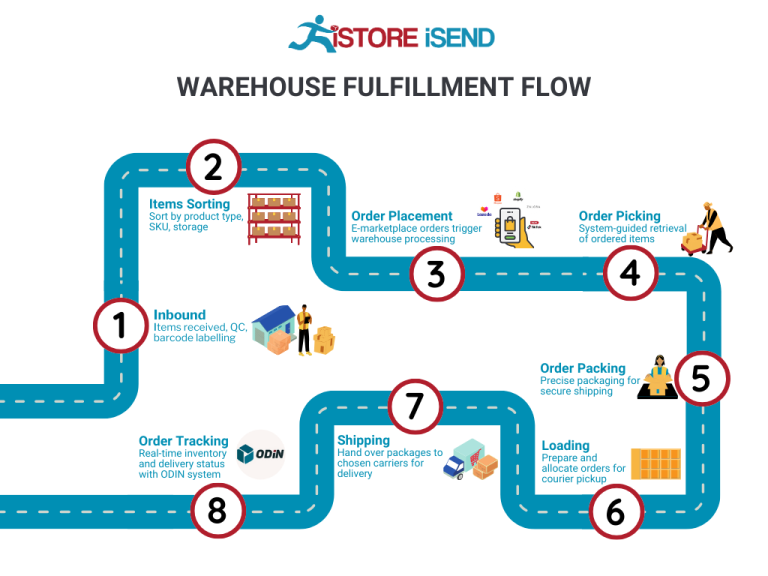
Key Term: ABC Analysis – This is a method used to categorize inventory based on sales volume and value, helping to optimize storage locations and streamline picking processes.
3. Order Picking
Order picking is the process of selecting items from the warehouse to fulfill customer orders. This step typically involves using pick lists, which are generated based on incoming orders. Workers, often assisted by technology, navigate the warehouse to gather the required products. Advanced fulfillment centers like Amazon’s BFI4 utilize robotics and automation to enhance picking efficiency.
Importance: The accuracy and speed of order picking directly impact customer satisfaction. Quick and precise picking ensures that orders are fulfilled correctly and delivered on time, which is crucial for maintaining a competitive edge in e-commerce.
Key Term: Pick Lists – These lists detail the items and quantities needed for each order, serving as a roadmap for pickers to efficiently gather products.
4. Order Packing
After items are picked, they are sent to the packing station, where they are carefully packaged for shipment. This involves selecting appropriate packaging materials, ensuring that items are protected during transit, and labeling packages for delivery. Automation can assist in this stage, such as using tape dispensers that apply the right amount of tape to seal boxes.
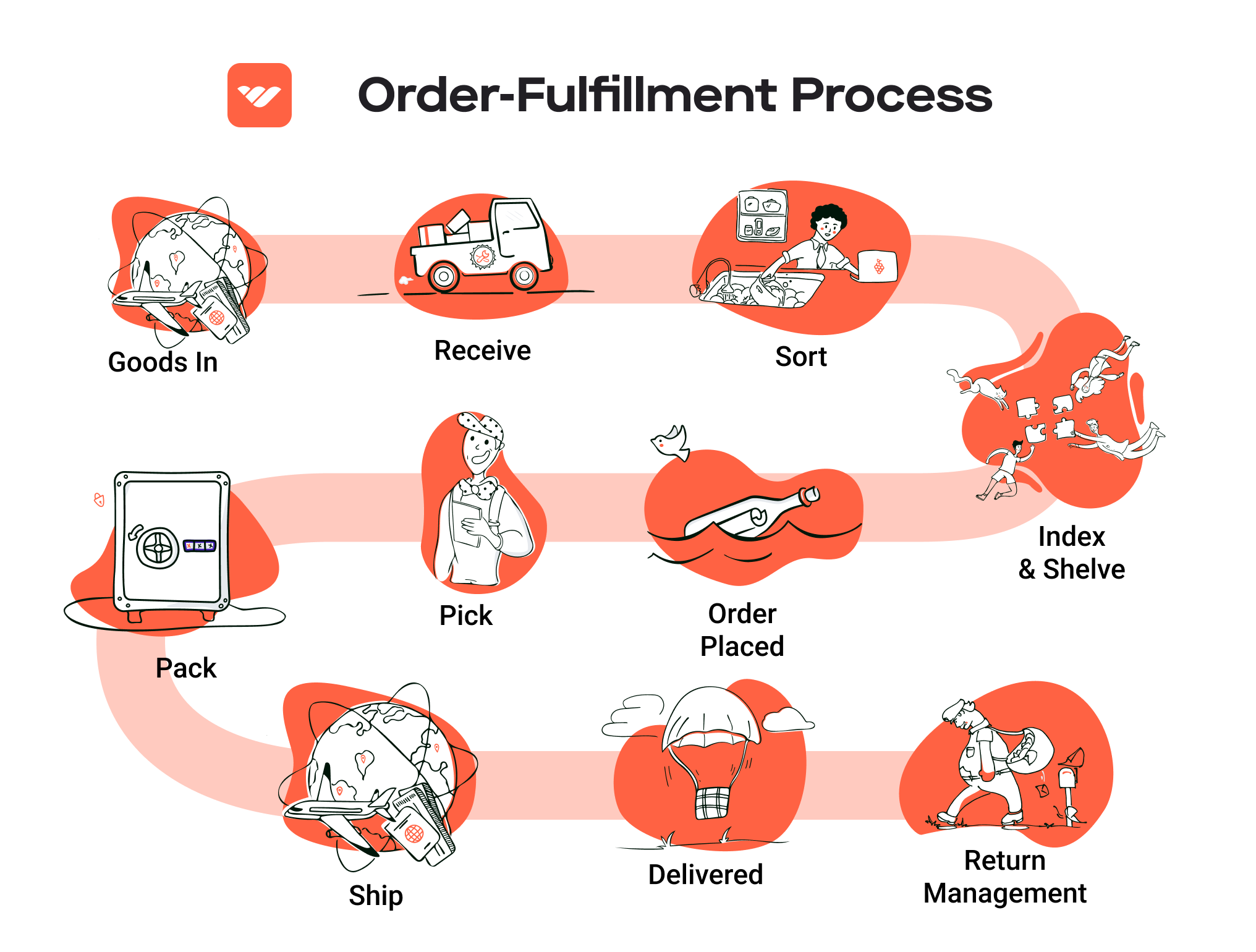
Importance: Proper packing is essential for preventing damage during shipping and ensuring compliance with shipping regulations. It also plays a role in branding, as well-packaged items enhance customer experience and perception of the brand.
Key Term: SLAM (Scan, Label, Apply, Manifest) – This process involves scanning items, applying shipping labels, and preparing packages for delivery, streamlining the packing workflow.
5. Shipping & Delivery
The final step in the order fulfillment process is shipping and delivery. Once packages are packed, they are loaded onto delivery trucks or carriers that transport them to the customer’s location. This stage requires coordination with logistics partners to ensure timely and accurate deliveries.
Importance: Efficient shipping and delivery are pivotal for customer satisfaction. In today’s fast-paced e-commerce environment, customers expect quick delivery times, and fulfillment centers must adapt to meet these demands.
Key Term: Last-Mile Delivery – This term refers to the final step of the delivery process, where the package is transported from a distribution center to the customer’s doorstep. Optimizing last-mile delivery is critical for enhancing customer satisfaction and reducing shipping costs.
By understanding and optimizing each of these five steps in the order fulfillment process, e-commerce businesses can enhance their operational efficiency, improve customer satisfaction, and ultimately scale their logistics effectively.
Comparing Fulfillment Models: In-House vs. 3PL vs. Dropshipping
Fulfillment Model Comparison
| Model | Who Handles Inventory | Best For (Business Stage) | Key Advantage | Key Disadvantage |
|---|---|---|---|---|
| In-House Fulfillment | The business itself | Established businesses | Full control over inventory and operations | High overhead costs and resource-intensive |
| Third-Party Logistics (3PL) | External logistics provider | Scaling businesses | Cost-effective and access to expertise | Less control over inventory and operations |
| Dropshipping | Supplier or manufacturer | Startups and small businesses | Low overhead and no inventory risk | Lower profit margins and longer shipping times |
In-House Fulfillment
In-house fulfillment is when a business manages its own warehousing, inventory, and shipping processes. This model is typically adopted by established businesses that have the resources to maintain a dedicated fulfillment operation. The key advantage of in-house fulfillment is the complete control it affords over inventory management, order accuracy, and customer service. Businesses can tailor their fulfillment processes to their specific needs, ensuring consistency and potentially enhancing customer satisfaction. However, the downsides include high overhead costs associated with maintaining a warehouse, hiring staff, and investing in technology. Additionally, managing logistics can be resource-intensive, pulling focus from core business activities such as marketing and product development. For businesses looking to scale, the in-house model may become increasingly challenging as order volumes grow.
Third-Party Logistics (3PL)
Third-party logistics (3PL) involves outsourcing logistics and fulfillment services to an external provider. This model is particularly advantageous for businesses that are scaling and require flexible, cost-effective solutions. By partnering with a 3PL, businesses can benefit from the provider’s expertise in inventory management, shipping, and logistics technology. This can lead to reduced operational costs, as businesses do not have to invest heavily in warehousing or logistics infrastructure. Additionally, 3PLs often have established relationships with carriers, which can lead to better shipping rates and faster delivery times. However, the downside of this model is the loss of control over inventory and fulfillment processes. Businesses may face challenges in maintaining consistent quality and service levels, and any issues that arise with the 3PL can directly impact customer satisfaction.
Dropshipping
Dropshipping is a fulfillment model where the retailer does not hold inventory but instead transfers customer orders directly to a supplier or manufacturer. This model is often favored by startups and small businesses because it requires minimal upfront investment and eliminates the risks associated with unsold inventory. The key advantage of dropshipping is the low overhead; businesses can operate without the need for physical storage space or extensive logistics capabilities. This allows entrepreneurs to focus on marketing and customer acquisition rather than on inventory management. However, dropshipping also comes with significant disadvantages. Profit margins can be lower due to the costs associated with purchasing from suppliers. Additionally, shipping times may be longer, as products often come from distant suppliers, which can lead to customer dissatisfaction. Furthermore, businesses have limited control over product quality and fulfillment processes, which can affect their brand reputation.
Conclusion
Selecting the right fulfillment model depends on your business stage, resources, and strategic goals. In-house fulfillment offers control and customization but at a higher cost and complexity. Third-party logistics provide expertise and scalability but can lead to diminished control over your operations. Dropshipping is an attractive option for new businesses looking to minimize risk, but it may come at the expense of profit margins and customer satisfaction. Understanding these models will help e-commerce business owners, operations managers, and entrepreneurs make informed decisions that align with their growth objectives.
A Deep Dive into Amazon FBA: Pros, Cons, and Who It’s For
Understanding Fulfillment by Amazon (FBA)
Fulfillment by Amazon (FBA) is a service that allows e-commerce sellers to store their products in Amazon’s fulfillment centers, where Amazon takes care of storage, packaging, shipping, and customer service on behalf of the sellers. This means that when a customer places an order, Amazon handles everything from picking the product from the warehouse to delivering it to the customer’s doorstep. Sellers simply need to manage their inventory and list their products on Amazon.
The FBA program is designed to help sellers scale their businesses by leveraging Amazon’s extensive logistics network and customer trust. With FBA, sellers can offer Prime shipping, which significantly enhances their product visibility and appeal to customers who prioritize fast delivery.
How FBA Works
-
Product Listing: Sellers create product listings on Amazon’s platform and indicate that they want to use FBA.
-
Shipping to Amazon: Sellers send their products to Amazon’s fulfillment centers. Amazon provides guidance on how to prepare and package products for shipment.
-
Storage: Once the products arrive, they are stored in Amazon’s warehouses. Sellers can track their inventory through the Amazon Seller Central dashboard.
-
Order Fulfillment: When a customer places an order, Amazon picks, packs, and ships the product. Amazon also handles returns and customer service inquiries related to FBA products.
-
Customer Service: Amazon provides customer service for FBA orders, including managing returns, refunds, and inquiries, allowing sellers to focus on other aspects of their business.
Pros of Using FBA
Prime Eligibility
One of the most significant advantages of using FBA is the ability to offer Prime shipping. Products fulfilled by Amazon are eligible for Amazon Prime, which can lead to increased sales. Prime members often prefer products with Prime eligibility due to the promise of fast, free shipping, making it a crucial factor in purchasing decisions.
Customer Trust
Amazon is known for its exceptional customer service and fast delivery. By using FBA, sellers benefit from the credibility and trust associated with Amazon. Customers are more likely to purchase from sellers who use FBA because they know that Amazon will handle their orders professionally.
Multi-Channel Fulfillment
FBA allows sellers to fulfill orders not just from Amazon but from other sales channels as well. This means that if a seller has their own website or sells on other platforms like eBay or Shopify, they can still use FBA to handle shipping and customer service. This integration streamlines operations and helps sellers manage their inventory more efficiently.
Simplified Logistics
FBA takes the complexity out of logistics for sellers. From warehousing to shipping, Amazon manages the entire fulfillment process, allowing sellers to focus on sourcing products and marketing their businesses. This is particularly beneficial for small to medium-sized businesses that may not have the resources to manage logistics independently.
Cons of Using FBA
High Fees
One of the drawbacks of FBA is the associated costs. Amazon charges various fees, including storage fees (monthly and long-term) and fulfillment fees per unit sold. These fees can quickly add up, especially for sellers with low-margin products, impacting overall profitability.
Strict Inventory Rules
Amazon has specific guidelines regarding inventory management, including labeling requirements and limits on the number of units that can be sent to fulfillment centers. Sellers must adhere to these rules or risk having their inventory returned or disposed of, which can disrupt their operations and sales.
Commingling Risks
When sellers use FBA, their inventory may be commingled with other sellers’ products. While this can streamline the fulfillment process, it also poses risks. If a customer receives a defective item that was not from the seller’s inventory, it can lead to negative reviews and return issues. Additionally, sellers may find it challenging to track their inventory accurately due to this commingling.
Dependency on Amazon
Using FBA can lead to a dependency on Amazon’s platform. Sellers might find it challenging to diversify their sales channels or switch to other fulfillment methods if they become too reliant on Amazon’s logistics. This dependency can pose risks if Amazon changes its policies or fees.
Who is FBA Best For?
Fulfillment by Amazon is particularly well-suited for:
-
Small to Medium-Sized Businesses: Companies that lack the resources to manage their own logistics can benefit significantly from FBA’s streamlined operations.
-
Sellers with High-Volume Products: Businesses that sell products with high turnover rates can offset the costs associated with FBA fees, making it a financially viable option.
-
Brands Looking to Enhance Visibility: Sellers aiming to boost their visibility on Amazon can leverage Prime eligibility and customer trust to drive sales.
-
Multi-Channel Sellers: Those selling across various platforms will find FBA advantageous for managing fulfillment in a centralized manner.
In conclusion, while Fulfillment by Amazon offers numerous benefits that can help sellers scale their operations, it is essential to weigh these against the potential drawbacks. By understanding the pros and cons of FBA, e-commerce business owners can make informed decisions that align with their growth strategies.
Core Services Offered by Fulfillment Centers
Inventory Management & Warehousing
Inventory management and warehousing are foundational services provided by fulfillment centers. This process involves the systematic tracking of inventory levels, orders, sales, and deliveries. Fulfillment centers utilize sophisticated software solutions that provide real-time visibility into stock levels, enabling businesses to optimize their inventory without overstocking or stockouts.
Benefits:
For e-commerce businesses, effective inventory management means improved cash flow and reduced carrying costs. By leveraging advanced warehousing techniques, such as automated storage and retrieval systems, fulfillment centers can maximize space utilization and streamline operations. This efficiency translates into faster order processing times and more accurate order fulfillment. Additionally, having a centralized location for inventory reduces shipping times, ultimately leading to enhanced customer satisfaction.
Pick and Pack Services
Pick and pack services are essential for any e-commerce operation looking to scale. This service involves selecting (or “picking”) items from the warehouse based on customer orders and then packing them securely for shipment. Fulfillment centers typically employ a combination of automated systems and human labor to ensure efficiency and accuracy in this process.
Benefits:
The primary advantage of pick and pack services is the ability to scale operations quickly and efficiently. As order volumes increase, fulfillment centers can adapt by optimizing their picking routes and packing methods, which reduces handling times and errors. Furthermore, accurate picking and packing minimize returns due to incorrect shipments, thereby enhancing the overall customer experience. This service also allows businesses to offer customization options, such as gift wrapping or including promotional materials, which can further drive customer loyalty.
Kitting and Assembly
Kitting and assembly services involve the grouping of multiple products into a single package, which is especially useful for businesses that sell bundled products or require assembly before shipping. This service can include anything from simple bundling of products to more complex assembly tasks, where items need to be put together before they can be shipped to customers.
Benefits:
For e-commerce businesses, kitting and assembly can significantly reduce the time and labor costs associated with preparing orders. By outsourcing these tasks to fulfillment centers, companies can focus on core business activities, such as marketing and product development. Moreover, offering kits or assembled products can increase average order values and provide customers with a more appealing shopping experience. This service also allows businesses to respond quickly to market trends by easily creating promotional bundles or seasonal offerings.
Returns Management (Reverse Logistics)
Returns management, or reverse logistics, is a critical aspect of fulfillment services that handles the process of product returns from customers. This includes the receipt of returned items, assessment of their condition, restocking, and processing refunds or exchanges. Efficient returns management is essential for maintaining customer trust and satisfaction.
Benefits:
The benefits of a streamlined returns management process cannot be overstated. For e-commerce businesses, a well-handled returns process fosters customer loyalty, as consumers are more likely to shop with brands that offer hassle-free returns. Fulfillment centers can manage returns efficiently, assessing the condition of returned products and determining whether they can be restocked or need to be disposed of. This not only minimizes loss but also provides businesses with valuable insights into product performance and customer preferences. By effectively managing returns, companies can enhance their overall operational efficiency and improve their bottom line.
Conclusion
In summary, fulfillment centers like Amazon’s BFI4 provide essential services that can significantly enhance the operational efficiency of e-commerce businesses. From inventory management and warehousing to pick and pack services, kitting and assembly, and returns management, each service is designed to streamline processes and improve customer satisfaction. By leveraging these core services, businesses can scale their operations effectively and maintain a competitive edge in the ever-evolving e-commerce landscape.
How to Choose a Fulfillment Partner: A 6-Point Checklist
Location & Warehouse Network
Importance: The geographical location of your fulfillment partner’s warehouses can significantly impact shipping times and costs. A partner with a well-distributed network can help you reach your customers faster and at a lower shipping cost, enhancing customer satisfaction and potentially increasing sales.
Questions to Ask:
– Where are your warehouses located, and how do they align with my customer base?
– Can you provide shipping times and costs for my target regions?
– What is your strategy for expanding your warehouse network in the future?
Technology & Integrations
Importance: In today’s digital age, the technology used by your fulfillment partner is critical for efficiency and accuracy. Robust systems can streamline operations, manage inventory in real-time, and integrate seamlessly with your e-commerce platforms, which can reduce errors and improve customer experience.
Questions to Ask:
– What fulfillment technology do you use, and how does it benefit your operations?
– Do you offer integrations with major e-commerce platforms (like Shopify, WooCommerce, etc.)?
– How do you ensure data accuracy and security in your systems?
Specializations (e.g., cold storage, oversized items)
Importance: Different businesses have unique needs based on their products. If you sell perishable goods, for example, you’ll need a partner with cold storage capabilities. If your inventory includes oversized items, ensure your partner can handle those requirements efficiently.
Questions to Ask:
– What types of products do you specialize in handling?
– Do you have facilities for specific needs, such as temperature-controlled storage or handling fragile items?
– Can you manage custom packaging or kitting for unique products?
Scalability & Capacity
Importance: As your business grows, your fulfillment partner must be able to scale with you. A partner that can accommodate spikes in demand during peak seasons, such as holidays, will help you avoid stockouts and lost sales.
Questions to Ask:
– How do you handle fluctuations in order volume?
– What is your maximum capacity for storing inventory and processing orders?
– Can you provide examples of how you’ve successfully scaled operations for other clients?
Pricing and Contracts
Importance: Understanding the pricing structure and contract terms is essential to avoid unexpected costs that can erode your margins. Transparent pricing models allow you to budget effectively and assess the total cost of working with a fulfillment partner.
Questions to Ask:
– What is your pricing model (e.g., per order, per item, monthly fees)?
– Are there any hidden fees (e.g., for storage, returns, or special handling)?
– Can you explain the terms of the contract, including cancellation policies and service level agreements (SLAs)?
Customer Support & Reviews
Importance: Exceptional customer support is vital for resolving issues quickly and maintaining a smooth operation. Partnering with a fulfillment provider that has a reputation for good customer service can save your business time and money.
Questions to Ask:
– What customer support options do you offer (e.g., phone, email, chat)?
– What are your average response times for support inquiries?
– Can you provide references or case studies from current or past clients regarding their experience with your support services?
Conclusion
Selecting the right fulfillment partner is a critical step in scaling your e-commerce operations. By carefully evaluating potential partners based on these six key criteria, you can ensure that you choose a provider that aligns with your business goals and enhances your customer experience. Consider these questions as part of your due diligence process to make an informed decision that supports your growth strategy.
Understanding Fulfillment Pricing: A Breakdown of Common Fees
Initial Setup Fees
When partnering with a fulfillment center like Amazon’s BFI4, businesses often encounter initial setup fees. These costs typically cover the onboarding process, which may include account creation, integration with your e-commerce platform, and configuring your inventory management systems. Depending on the complexity of your operations, this fee can range from a few hundred to several thousand dollars.
Businesses should be prepared to provide detailed information about their products and shipping requirements to streamline the setup process. It’s also wise to inquire about any discounts available for long-term contracts or high-volume shipping, as these can help offset initial costs.
Receiving Fees
Receiving fees are charged when the fulfillment center takes possession of your inventory. This fee generally covers the labor and resources required to unload, inspect, and store your products. At BFI4, receiving fees may vary based on the size and weight of the items, as well as the total number of units being processed.
Typically, fulfillment centers charge per pallet or per item. For instance, receiving a standard pallet could incur a fee of $30 to $50, while smaller items might be charged at a per-item rate of $0.20 to $0.50. To minimize these fees, businesses can plan shipments to consolidate products and reduce the number of receiving events.
Storage Fees (per pallet/bin)
Storage fees are incurred for keeping your inventory in the fulfillment center. These fees are usually calculated on a monthly basis and can vary depending on the volume of space your products occupy. For instance, at BFI4, storage fees may be structured around the size of the pallet or the bin, with typical costs ranging from $10 to $25 per pallet per month.
It’s crucial for businesses to monitor their inventory turnover rates. High storage fees can accumulate if products remain in the warehouse for extended periods. To mitigate costs, companies should develop effective inventory management strategies, such as seasonal promotions or bundling products to boost sales velocity.
Pick & Pack Fees (per item/order)
Pick and pack fees are charged for the labor involved in retrieving items from storage and packing them for shipment. This fee is typically calculated per item or per order. For example, fulfillment centers like BFI4 may charge $1 to $3 per item for picking, and an additional $0.50 to $1.50 per order for packing.
Businesses can optimize their pick and pack costs by ensuring that their product listings are accurate and that inventory is organized efficiently. Implementing software that streamlines order processing can also reduce errors, ultimately lowering labor costs.
Shipping Fees
Shipping fees encompass the costs associated with sending orders to customers. These fees can vary widely based on factors such as package size, weight, destination, and shipping method (e.g., standard, expedited). Fulfillment centers usually offer competitive shipping rates due to their volume discounts with carriers.
At BFI4, businesses can expect to see shipping fees calculated per package, with costs typically ranging from $5 to $15 for standard shipping. To get the best rates, consider negotiating with your fulfillment partner to leverage their carrier relationships, or explore options for flat-rate shipping, which can provide more predictable costs.
Tips for Getting an Accurate Quote
To secure an accurate fulfillment pricing quote, businesses should take the following steps:
-
Provide Comprehensive Information: Be clear about your product types, sizes, weights, and expected order volumes. This information will help the fulfillment center calculate fees more accurately.
-
Understand Your Needs: Assess your unique logistics requirements, including storage duration, peak seasons, and shipping methods. This understanding allows you to ask targeted questions.
-
Request Itemized Quotes: Ask for a detailed breakdown of all potential fees, including any hidden costs. This transparency will help you understand the total cost of services.
-
Compare Multiple Providers: Don’t settle for the first quote. Compare several fulfillment centers to find one that meets your operational needs and budget.
-
Inquire About Discounts: Ask if there are volume discounts or special pricing available for long-term contracts, as these can significantly reduce overall costs.
By following these tips and understanding the various fee structures, e-commerce businesses can make informed decisions that align with their growth strategies and operational goals.
Frequently Asked Questions (FAQs) about Fulfillment
1. What is the Amazon Fulfillment Center BFI4?
BFI4 is Amazon’s flagship fulfillment center located in Kent, Washington. It is one of the largest and most technologically advanced facilities in Amazon’s network, capable of processing over one million packages daily through a combination of advanced robotics and sophisticated algorithms.
2. How does BFI4 differ from a traditional warehouse?
A fulfillment center like BFI4 focuses on the rapid processing and shipping of customer orders, leveraging technology to optimize operations. In contrast, a traditional warehouse primarily serves as a storage space for inventory without the same emphasis on quick order fulfillment and shipping efficiency.
3. What technology is used at BFI4 to manage fulfillment?
BFI4 employs a variety of technologies, including automated robots for transporting goods, conveyor systems for sorting, and sophisticated software for tracking inventory and managing orders. This technology enables high efficiency and accuracy in fulfilling customer orders.
4. What is a Third-Party Logistics Provider (3PL)?
A 3PL is a company that provides outsourced logistics services, which can include transportation, warehousing, and fulfillment. Businesses often use 3PLs to leverage their expertise and technology to improve supply chain efficiency without needing to manage these operations in-house.
5. How much do fulfillment services at Amazon cost?
Costs for fulfillment services vary based on several factors, including the size and weight of products, storage duration, and the volume of orders. Amazon provides a pricing calculator within its Seller Central platform to help businesses estimate their fulfillment costs based on their specific needs.
6. Can I visit the Amazon Fulfillment Center BFI4?
Yes, Amazon offers public tours of the BFI4 fulfillment center. These tours provide insights into the operational processes, technology, and the role of robotics in fulfillment, allowing visitors to see how their orders are processed after clicking “Buy Now.”
7. What types of products can be fulfilled through BFI4?
BFI4 can handle a wide range of products, including electronics, household goods, apparel, and more. However, certain restricted items such as hazardous materials or perishables may not be eligible for fulfillment through this center.
8. What safety measures are in place at BFI4?
BFI4 prioritizes safety with a range of measures, including comprehensive training for employees, regular safety audits, and the integration of technology to minimize risks. Safety protocols are continuously updated to meet or exceed industry standards.
9. How does Amazon ensure the accuracy of orders fulfilled at BFI4?
Amazon utilizes a combination of technology and rigorous quality control processes to ensure order accuracy. Automated systems assist in picking and packing, while human oversight and scanning procedures help verify that the correct items are shipped to customers.
10. What should I consider when choosing a fulfillment partner like Amazon?
When selecting a fulfillment partner, consider factors such as cost, technology capabilities, scalability, geographic reach, and customer service. It’s crucial to evaluate how well the partner aligns with your business goals and can adapt to your growth and changing logistics needs.
Conclusion: Is Outsourcing Fulfillment the Right Move for Your Business?
Evaluating the Decision to Outsource Fulfillment
Outsourcing fulfillment can be a game-changer for e-commerce businesses aiming for growth and efficiency. One of the primary benefits is the significant time savings; by partnering with a specialized fulfillment service, you can redirect your focus from logistics to core business activities such as marketing, product development, and customer engagement. This shift allows you to respond more rapidly to market demands and customer needs.
Scalability is another critical advantage. Fulfillment services, particularly those utilizing advanced technologies like Amazon’s BFI4 center, can easily adapt to fluctuations in order volume, whether it’s during peak seasons or unexpected surges in demand. This flexibility ensures that your business can scale without the need for substantial capital investment in warehouse space, technology, or labor.
Moreover, partnering with an expert in fulfillment not only enhances operational efficiency but also improves customer satisfaction. These partners bring specialized knowledge and resources that can streamline your supply chain, optimize inventory management, and enhance shipping accuracy and speed. In today’s competitive landscape, delivering a superior customer experience is essential for retention and growth.
However, the choice of fulfillment partner is paramount. Not all services are created equal; it’s crucial to assess their capabilities, technology, and reputation in the industry to ensure alignment with your business goals.
As a strategic next step, consider auditing your current shipping process. Evaluate the costs, efficiency, and customer feedback related to your fulfillment operations. This analysis will provide valuable insights into whether outsourcing fulfillment could be the right move for your business. Embrace the opportunity to enhance your operational efficiency and focus on what you do best—growing your business.
Important Disclaimer
⚠️ Important Disclaimer
The information in this guide is for educational purposes. Fulfillment services, pricing, and platform features change frequently. Always conduct your own due diligence and consult with providers directly before making business decisions.
